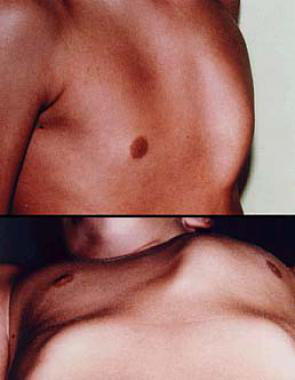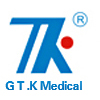Pectus Carinatum
Updated: Oct 13, 2015 /Author: Mary E Cataletto, MD; Chief Editor: Michael R Bye, MD
Background
Pectus carinatum (ie, carinatum or keel-shaped deformity of the chest) is a term used to describe a spectrum of protrusion abnormalities of the anterior chest wall (see the image below).

Pectus carinatum. Photograph courtesy of K. Kenigsberg, MD.
The deformity may be classified as either chondrogladiolar or chondromanubrial, depending on the site of greatest prominence. Lateral deformities are also possible.
Hippocrates described the carinatum deformity as a "sharply pointed chest" and reported that patients became "affected with difficulty breathing." Symptomatic patients report dyspnea and decreased endurance. Some develop rigidity of the chest wall with decreased lung compliance, progressive emphysema, and increased frequency of respiratory tract infections. [1] Many affected patients have no physical complaints; however, concerns about body image have been associated with low self-esteem and a decreased mental quality of life. [2] Cosmetic concerns can be significant factors in opting for correction.
Barrel chest deformities with increased anteroposterior (AP) chest diameters can be seen in obstructive forms of chronic pulmonary disease, such as cystic fibrosis and untreated or poorly controlled asthma.
Pathophysiology
Until recently, most cases of pectus carinatum deformity were thought to be asymptomatic. However, little is known about the cardiopulmonary function. In 1989, Derveaux reported a series of patients with no significant preoperative or postoperative respiratory compromise. [3]However, some patients develop a rigid chest wall, in which the AP diameter is almost fixed in full inspiration. In these patients, respiratory efforts are less efficient. Vital capacity is reduced, and residual air is increased. Alveolar hypoventilation may ensue, with arterial hypoxemia and the development of cor pulmonale. As the lungs lose compliance, incidence of emphysema and frequency of infection are increased. Most recently, Fonkalsrud (2008) reported his personal experience of 260 patients, all of whom were symptomatic. [4]Symptoms that were reported included dyspnea, exertional tachypnea, and reduced endurance.
In 1990, Iakovlev and colleagues studied the cardiac functions of 70 patients with pectus carinatum deformity. [5] Mitral valve prolaspse was identified in 97%. Rhythm disturbances and decreased myocardial contractility were less frequently observed, along with other cardiac and hemodynamic changes. Cardiac and hemodynamic changes were more commonly observed in patients with chondromanubrial prominence.
Epidemiology
Frequency
United States
Pectus excavatum is more common than the carinatum deformity. The overall prevalence of pectus carinatum is estimated at 0.06%. [6]Fonkalsrud (2008) reported that at least 25% patients have a positive family history of chest wall deformity. [4]Pectus carinatum can also be seen in association with Marfan Syndrome and congenital heart disease.
International
The percentage of chest wall deformities represented by pectus carinatum are greater in reports from Brazil [7] and Argentina. [8]
Mortality/Morbidity
Psychological and cosmetic concerns are the most prominent reasons for initial consultation. However, Fonkalsrud (2008) reported that surgical repair is rarely performed only for cosmetic reasons. [4]Morbidity in later years includes cardiac and hemodynamic changes.
Race
The conditions is more frequent in whites and is uncommon in blacks and Asians.
Sex
Males are affected 4 times more frequently than females. Because this deformity may occur either in isolation or as part of a syndrome, identifying a single etiology for the male predominance is difficult.
Age
Although pectus carinatum has been described at birth, it is most frequently identified in mid childhood. The deformity often worsens during the adolescent growth spurt.









